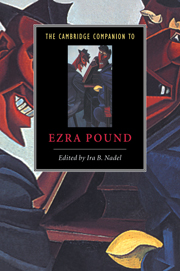Book contents
- Frontmatter
- 1 Introduction Understanding Pound
- 2 Pound and the making of modernism
- 3 Early poetry 1908-1920
- 4 Early Cantos I-XLI
- 5 Middle Cantos XLII-LXXI
- 6 Late Cantos LXXII-CXVII
- 7 Beyond The Cantos
- 8 The texts of The Cantos
- 9 Pound as critic
- 10 Pound as translator
- 11 Pound and the visual arts
- 12 Pound and music
- 13 Pound's politics and economics
- 14 Pound, women and gender
- 15 Pound and antisemitism
- Further reading
- Index
11 - Pound and the visual arts
Published online by Cambridge University Press: 28 May 2006
- Frontmatter
- 1 Introduction Understanding Pound
- 2 Pound and the making of modernism
- 3 Early poetry 1908-1920
- 4 Early Cantos I-XLI
- 5 Middle Cantos XLII-LXXI
- 6 Late Cantos LXXII-CXVII
- 7 Beyond The Cantos
- 8 The texts of The Cantos
- 9 Pound as critic
- 10 Pound as translator
- 11 Pound and the visual arts
- 12 Pound and music
- 13 Pound's politics and economics
- 14 Pound, women and gender
- 15 Pound and antisemitism
- Further reading
- Index
Summary
Ezra Pound wrote a good deal of art journalism and criticism, participated actively in one art movement, Vorticism, and wrote extensively in his poetry and prose about the effect chosen instances of art, particularly Italian Renaissance and modernist art, had on his sensibility and thinking. Aside from his 1916 book, Gaudier-Brzeska: A Memoir, his writing on art has been collected in Ezra Pound and the Visual Arts (1980), and most of the details of his varied interests in the visual arts have been carefully studied by a number of different critics. This essay is not one more detailed study of an aspect of Pound's interests in the visual arts as much as a synoptic overview of those interests. What, if anything, links and renders coherent Pound's varied interests in art? More importantly, what motivated Pound's interest in the visual arts?
Pound's interest in the visual arts offers a significant contrast to his interest in music. There are, of course, some similarities between the two interests. His opinions about music and painting were both widely divergent from received notions, both in his praise of modern artists such as Henri Gaudier-Brzeska and George Antheil, and in his intemperate dismissal of Rubens and Rembrandt and the entire solo piano repertoire. We have not quite known how to learn from Pound's consciously eccentric views without adopting all of them, but for me the value of Pound's criticism is at both extremes of the range, rarely in the middle (fortunately, he is rarely in the middle).
- Type
- Chapter
- Information
- The Cambridge Companion to Ezra Pound , pp. 224 - 235Publisher: Cambridge University PressPrint publication year: 1999



